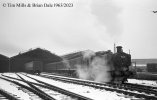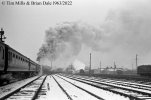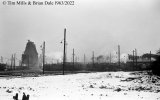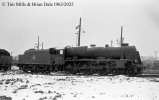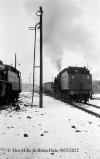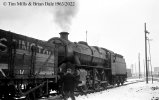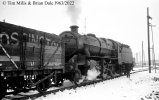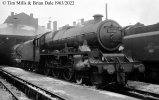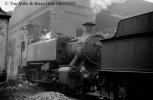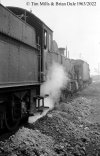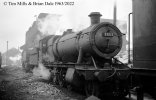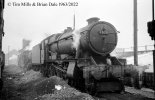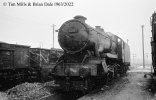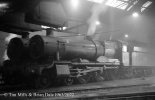Thank you, Simon and Dave, for "more and better particulars" - well, nor necessarily better, but I'm sure you catch my drift. And that's a lovely model of a (probably) rarely if ever modelled prototype. As it was on shed at Old Oak with the oil fitted accoutrements I guess they must have had a suitable oil supply there. Although I saw the loco I never noted the differences between it and the standard 57XXs (of which there were many!)
Here's some proof of the bitterly cold weather of 1963.
Somewhat out of character Tim recorded details of all the locos in this string. They are Princess Coronation 46237 City of Bristol, Jubilee 45567 South Australia and Black 5 44875 at Willesden in February 1963. The Coronation was previously in post #905. 46237 had been a Carlisle Upperby engine since April 1962 and the 12B shed plate confirms the allocation. It was withdrawn from Carlisle in September 1964, went to Arnott Young at Troon and had ceased to exist by the end of the year.
45567 was a Crewe North engine, moving to Llandudno Junction in October 1964 then back to Crewe North at the end of January 1965 when it was immediately withdrawn. (SLS). It went to Cashmore's, Great Bridge, where it was scrapped in May 1965. (BR Database).
The Black 5 had been a Bescot engine since April 1960, thence to Stourbridge Junction in June 1966, Llandudno Junction the following June and finally Chester in October 1966 where it was withdrawn in May 1967. (SLS). It then went to Cohen's, Morriston, where it was scrapped in September. (BR Database).
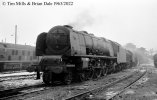
The named Black 5s were rare visitors to Willesden but here is 45154 Lanarkshire Yeomanry at Willesden in February 1963. It belonged to Newton Heath at the time and moved around too many sheds to list here before ending up at Speke Junction in March 1965 where it was withdrawn in November 1966. (SLS). It went to Draper's at Hull for disposal which was completed by the end of May 1967. (Rail UK).
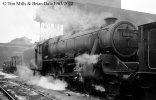
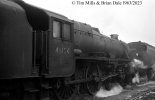
Castle 4082 Windsor Castle at Old Oak in February 1963. I'm finding the BR Database record a bit difficult to understand as it shows a name and number change for 4082 to 7013 Bristol Castle in 1952. Help to clarify will be welcome! 4082 can be seen to be carrying an "81" shed plate although the figure under the number can't be read. This would fit with the BR Database info which says that the loco was shedded at and stored at Old Oak Common in 1963 where it was reinstated in April 1964, going to Tyseley in June and withdrawn in September. The SLS records show it to have been a Worcester (85A) engine in 1963 which doesn't agree with the shed plate in the photo, then Cardiff East Dock in Mrch 1964, Old Oak in April 1064 and finally Tyseley in July 1964 where it was withdrawn in February 1965. I've no idea whether either of these is correct! BR Database and Rail UK record it as scrapped at Cashmore's, Newport, in January 1965 so the withdrawal date of February 1965 proposed by the SLS must be incorrect.
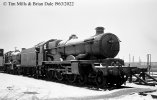
Brian
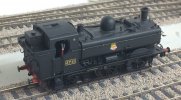





 44875 should have read April 66 to Stourbridge Junction and Llandudno Junction the following June which makes rather more sense. However, still not as concise as Martin's evidence so thanks to both for querying and checking.
44875 should have read April 66 to Stourbridge Junction and Llandudno Junction the following June which makes rather more sense. However, still not as concise as Martin's evidence so thanks to both for querying and checking.
